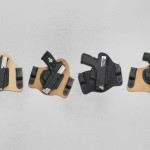The term “Retzev” seems to be vastly misunderstood, given the wealth of questionable information I have found on the subject lately. And, often, instructors use the term as proof to new students that each is qualified to teach Krav Maga. What better way to impress a potential student than to pull out a few Hebrew words – authentic right? Some students use the term with bravado to impress others with their knowledge of the system they practice. But what is Retzev?
Retzev Defined
Retzev is Hebrew and translated means “continuous motion”, but as with all things, head knowledge is not the same as operational knowledge. It’s in this seemingly small difference that major misconceptions emerge. Retzev is most commonly referred to incorrectly as a combative theory or directive. The truth is, Retzev is a concept that urges the Krav Maga practitioner to utilize and harness the natural power in movement throughout both defensive and offensive initiatives within a self-defense technique(s).
Before I go further into the subject, it might do us some good to consider another Hebrew term, “stom” (sometimes also seen as “en stom”). It means, not for nothing. In other words, everything you’re doing within a Krav Maga or an effective self-defense technique should have a purpose directly linked to the objective (that is, to stop the attack and render the danger impotent). Thinking of Retzev in this way should shed some light on the concept.
Retzev is, by extended definition, not ineffective motion no matter how continuous. Retzev is bound by the principles of Krav Maga and also by the concept of effectiveness as applied to an objective (in this case, to actively neutralize a threat). Keep this simple idea in mind as you think through the concept of Retzev.
As students, we don’t always consider the concept of Retzev, because so much of the concept is already built into the Krav Maga system (via the techniques). And, the way the techniques unfold provides a sense of timing and fluidity that should be harnessed if possible. I describe this to my students using the analogy of a stock car race. Yes, the subject of NASACR has made its way into Kravology.
Essentially, a NASCAR driver is always going fast – really fast. He or she usually makes (what end up being) a series of left turns around a large, oval 2-mile track. When a driver completes the race individually, he or she usually goes faster than when on the track with 50 or so other cars. Think of the cars as impediments – those things that can get in the way of you perfectly executing your technique.
Attackers can slows things down a bit, as can the curves of the track (where drivers lose up to 30-40 MPH down-shifting to avoid hitting the outside wall and/or drifting into other cars). But, the drivers are still driving really fast. Sometimes, drivers hit the breaks to avoid a crash, and then accelerate once clear. Drivers always want to go fast, but the degree of speed is determined by (1) the track size and shape, (2) the location of other cars, and (3) those “in the moment” happenings on the track that demand a response.
Self-defense is no different. Retzev is, therefore, the continuous motion utilized in pursuit of a self-defense objective – preserving and harnessing balance, weight, power, and speed intuitively and naturally (as the body is made to move) to defeat a threat.
Retzev – in a vacuum – might look something like a violent dance. Operationally, it is the optimization of movement to end violent conflict. Some major potential issues in optimizing Retzev include:
(1) The angle of attack (and response) that often dictates multiple movements from the same side prior to more optimized weight sharing between the feet from a more squared or advantageous position,
(2) The distance of the attack that dictates from where the response occurs, and how far the defender must move into the attacker to achieve a control position or other objective,
(3) The height of the attack and the required response – moving the defender’s platforms in various and perhaps sub-optimal ways prior to more optimized weight sharing between the feet from a more squared or advantageous position,
(4) Where the weight in the feet and in the body is located as a threat develops and demands a response, and
(5) The attackers response to the defender’s initiatives, including but not limited to physical resistance, countering with combatives and/or other violent actions, pinning or otherwise restricting the defender’s movement and/or range of motion, pushing and/or pulling, and so on.
Notice that, as an attacker supplies some violence or force that negatively effects your platforms (shoulders, hips, and feet/ankles), your natural capacity to respond with Retzev is somewhat compromised – due primarily to decreased strength, balance, leverage, and so on (in the same way, essentially, that cars cannot always run at maximum speed in a race as described above).
Therefore, Retzev is rarely optimally produced when the outside force of an attacker is presented but can be achieved at various, substantial levels and should be utilized whenever possible.
Avoid Training Scars
Retzev also is not simply hitting a target fast without any consideration of rhythm, weight shifting in the feet, power, and/or balance. However, many of the demonstrations I have seen tend to simplify the issue with nonsense-like speed. In fact, this rote process not only misses some key elements of the Retzev concept, it really creates a myriad of problems with self-defense by way of training scars. In the same way traditional Karate, as described in Bill Kipp’s book, Turning Fear into Power, develops sub-optimal combatives through an emphasis on punching to just miss the target (known as having control, this presents itself in violent confrontations as surface striking – totally ineffective).
Essentially, every motor skill you repeat in a specific way creates a higher probability that the next motor skill will look more and more like the previous one (check out the role of myelin and the resulting muscle memory within the pages of The Talent Code as described in the Required Reading section).
For example, think of someone demonstrating a right straight knee to the midline. The person demonstrating, in an effort to illustrate Retzev (in their mind meaning the speed of multiple combatives) delivers very short, quick knees that stop and retract 6-8 inches from the midline of the attacker. Not only is this not an adequate demonstration of Retzev, it’s also producing a high likelihood that, if attacked, the person demonstrating will make short, quick knees resulting in an ineffectual defense or offense.
Simply put, if you’re motor skill is developed and/or demonstrated consistently to illustrate speed, via stopping short of the actual distance to the target, then you’re training your body to miss the target by “pulling” the combative before striking to and through the target.
An Example
A simple example of Retzev could include:
The natural push and pull motion the body makes when delivering a straight left/right combination (the push/pull motion is aided by platform rotation and weight transfer). This could then be extrapolated to inside defense to a right straight punch – where the defender moves the left side in and forward powerfully to redirect the incoming right straight punch.
The right side of the defender’s body is now loaded as a result, and the weight can transfer to the right foot – allowing a strong counter right straight to quickly follow the left arm’s redirection. A left hook could follow the right straight, followed by a right hammerfist, followed by control position, and followed by several combatives that continue to utilize the concept of Retzev (do this and feel the rhythm it creates, but be sure to transfer your weight from foot to foot).
Put simply, Retzev is weight transfer in the feet that facilitates powerful, rhythmic movement with the express purpose of making defense and/or offense to end a violent conflict. Weight transfer facilitates and/or provides movement in all directions, rotation, pushing and pulling motions, bursting, head movement, and a continuous flow of motion (if you can capture the essence of the weight transfer).
When applied properly, an effective effort of Retzev will often short-circuit the attackers OODA Loop (for an OODA Loop explanation, check out the Situational Awareness article in the Methods section). In essence, when absorbing the power and sufficient speed of a continuous barrage of combatives, the attackers brain cannot process – within the time between each blow – what to do and how to do it. Retzev effectively blocks the attackers brain from (1) processing information about the defenders initiative, (2) making decisions based on that formation, and (3) physically acting on those decisions.
In short, the Retzev process overwhelms the attackers decision-making capacity. Frankly, this is the most important outcome of Retzev. Making an effort to end a violent altercation must not only include effective strikes but must also render the attacker unable to respond to those strikes. This is the foundational key.
An Exercise
Next time you’re training, move to an area where you can practice a technique “dry” – that is by yourself or “in the air.” You’ll need to find your natural rhythm – the rate at which you most effectively and comfortably transfer weight between your feet. Move your weight from foot to foot bouncing back and forth like a basic warm-up. It’s not difficult – some rhythms will feel rushed, other bogged-down and slow. Your natural rhythm will feel just right, because you’re transferring your weight in a rhythm that also allows your body and its platforms to move powerfully and in balance over and over again.
Use your natural rhythm as a guide to move through the technique you’ve chosen, shifting your weight from foot to foot as required by the techniques movements. If a movement requires a longer space between the beats of your natural rhythm, that’s fine – just adjust like a stock car driver downshifts in a curve and get back to the base rhythm when you feel it. Do everything in a rhythmic fashion – experiment with full beats, half beats, pauses, and full beats of the base rhythm. You’ll begin to feel how Retzev is built into the intention of the technique.
Next, use your natural rhythm to start shifting your weight from foot to foot slowly without actually picking your feet up off the ground – just back and forth. Start punching with the slow rhythm of your weight shifting. Slowly add hooks, uppercuts, elbows, kicks, knees and hammerfist punch utilizing the base rhythm.
As you progress, you might continue by varying the speed of the weight shift between the feet to accommodate each unique combative in the same way that you might clap to the beat of a song, then switch to the half beat, then back to the beat, etc. The basics remain, as does the underlying rhythm of the weight transfer. Once you have this, you can make Retzev – pausing, stopping, and starting as you wish or as the situation dictates. Have fun with it!
…walk in peace.





Joseph Willis
Subscribe me
David
Please sign me up
Eugene
Hi Byron, thanks for the academic approach to explaining Retvez. It seems that the vast majority of martial arts practice Retvez n not only limited to KM. If this is true, then would you say that Retvez is not uniquely in reference to KM alone? I see Retvez practiced in the Filipino martial arts like; Panatukan n Kali as well. Would u agree?
Carl
Byron – Thank you, good article. It’s important, imho, that the defender does more than just continuously attack unthinkingly, and you make that point well. I believe that assessment/evaluation should be going on just as continuously and, given the effects of adrenaline, that that might even be harder to incorporate into defense than is the proper physical action. It has to happen (or at least should happen) without compromising rhythm (or at least not very much). Consequences of ignoring assessment/evaluation and the decision making these imply are numerous and potentially costly. Not the least of these are tumbling over environmental objects and ending up on the ground unnecessarily, and recklessly crossing the line between being a defender and an aggressor. The second of these might not be very important in warfare or under certain extreme conditions of self defense such as those in which I understand Krav Maga was originally developed; but in common civilian contexts, it is.
Thx again.
Pingback: Relentless with Retzev – Krav Maga Mindset
Carl Ward
How do you write Retzev in Hebrew ?
Dwayne Hamblin
This was enlightening. Thanks for this.
David Sanchez
Thanks for the helpful explanation. Please sign me up for the weekly edition.